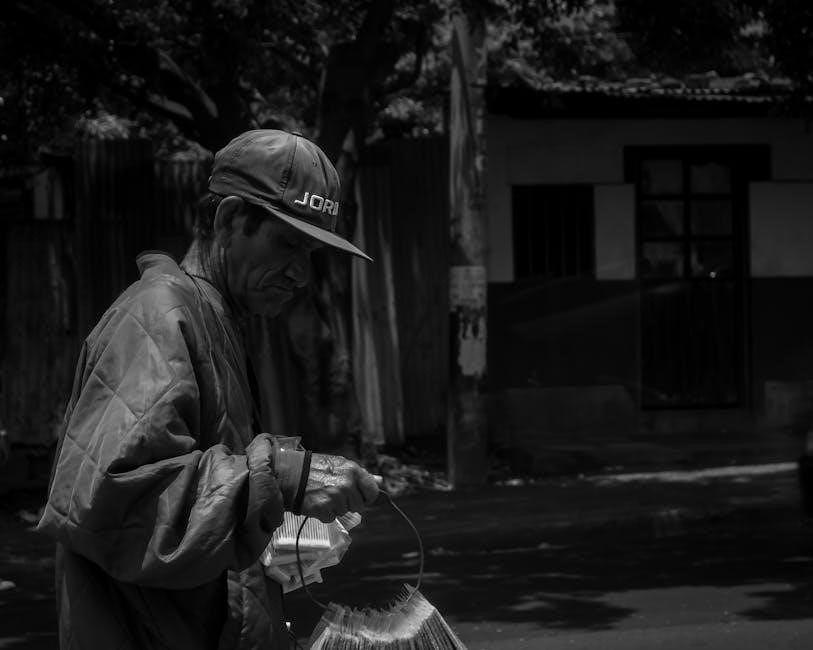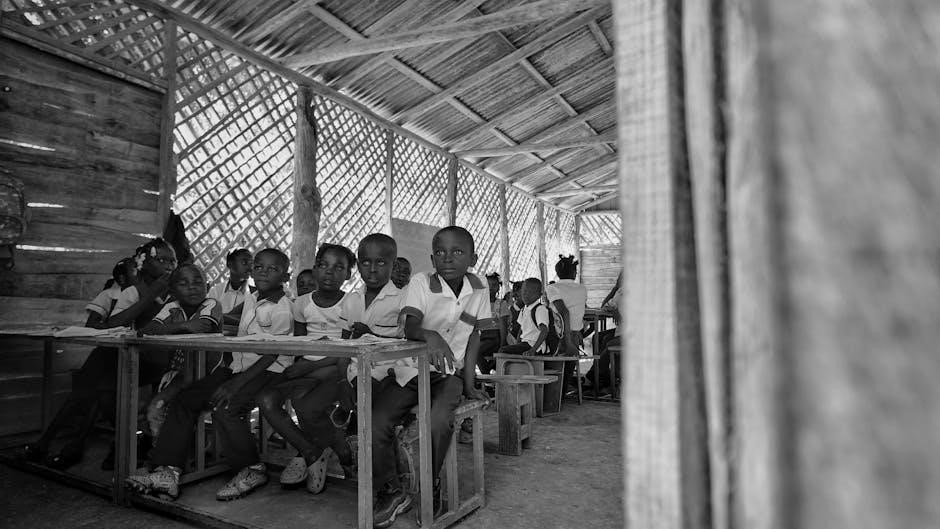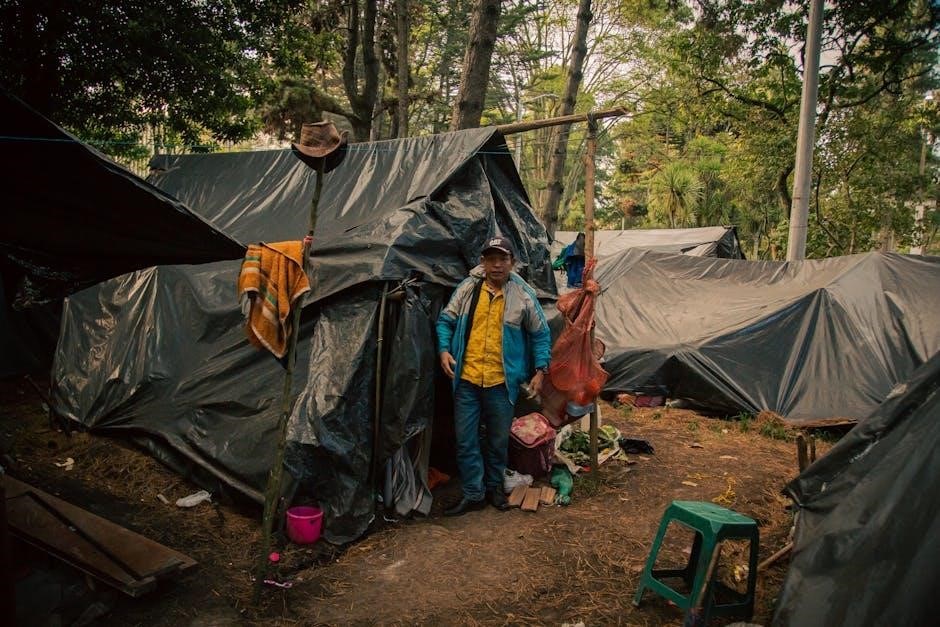
Poverty in America affects millions, with 37.9 million living below the poverty line in 2022. It impacts children, the elderly, and marginalized communities, highlighting systemic inequalities and societal challenges.
1.1 Definition of Poverty
Poverty is defined by the U.S. Census Bureau as living below income thresholds that vary by family size and composition; In 2022, 37.9 million Americans, or 11.5% of the population, lived below this line. This measure helps evaluate economic trends and understand disparities across demographic groups, providing insights into systemic inequalities and societal challenges.
1.2 Historical Context of Poverty in the U.S.
Poverty in the U.S. has fluctuated over time, influenced by economic downturns and policy changes. In 2015, 13.5% of Americans lived in poverty, down from 2014. The Great Recession pushed millions into financial distress, while COVID-19 relief measures temporarily reduced poverty. Historical data shows varied trends, with poverty rates declining before the pandemic but rising in 2022. Understanding this context is crucial for addressing ongoing economic and social disparities.
1.3 Importance of Studying Poverty
Studying poverty is essential for understanding economic trends and social disparities. It helps evaluate the effectiveness of policies and programs aimed at reducing inequality. Analyzing poverty data enables policymakers to address systemic issues, such as income inequality and access to resources. The U.S. Census Bureau’s reports provide critical insights, highlighting how poverty impacts vulnerable populations like children and the elderly. This knowledge is vital for creating targeted interventions to alleviate economic hardship and promote societal well-being.

Official Poverty Measure (OPM)
The Official Poverty Measure (OPM) defines poverty based on pre-tax income thresholds, assessing economic conditions and guiding policy. In 2022, 11.5% of Americans lived below this threshold.
2.1 Definition and Thresholds
The Official Poverty Measure (OPM) defines poverty based on income thresholds adjusted for family size and composition. In 2022, the threshold for a single person was $14,580, while for a family of four, it was $30,000. These thresholds determine eligibility for federal assistance and are used to evaluate economic conditions and policy effectiveness across the United States.
2.2 Limitations of the Official Poverty Measure
The Official Poverty Measure (OPM) has several limitations, including its failure to account for non-cash benefits like food stamps and housing subsidies. It also does not adjust for regional cost-of-living differences, potentially underestimating poverty in high-cost areas. Additionally, the OPM excludes certain income sources, such as tax credits, which can provide a more accurate picture of economic well-being. These limitations highlight the need for alternative measures, like the Supplemental Poverty Measure, to better capture poverty dynamics.
2.3 Recent Trends in OPM (2015-2023)
From 2015 to 2023, the Official Poverty Measure (OPM) showed fluctuating trends. Poverty rates declined steadily until 2020, but rose in 2022 due to inflation and reduced federal aid. Child poverty reached a record low in 2021 but increased in 2022. Regional disparities persisted, with higher poverty rates in the South and Appalachia. The OPM data highlights the impact of economic policies and external factors on poverty levels across the U.S.

Supplemental Poverty Measure (SPM)
The Supplemental Poverty Measure (SPM) provides a comprehensive assessment of poverty, incorporating non-cash benefits, taxes, and work expenses to better reflect economic well-being.
3.1 What is the Supplemental Poverty Measure?
The Supplemental Poverty Measure (SPM) is an alternative poverty metric developed by the U.S. Census Bureau. Unlike the Official Poverty Measure (OPM), the SPM considers various factors such as non-cash benefits, taxes, and work-related expenses. It also adjusts thresholds for regional cost-of-living differences, providing a more nuanced view of economic hardship. This measure aims to capture a broader understanding of poverty, including the impact of government policies and assistance programs.
3.2 Differences from the Official Poverty Measure
The Supplemental Poverty Measure (SPM) differs from the Official Poverty Measure (OPM) by including non-cash benefits like food stamps and housing subsidies, while deducting expenses such as taxes, childcare, and medical costs. It also adjusts for regional cost-of-living variations, offering a more comprehensive view of poverty. Unlike the OPM, the SPM provides insights into how government programs and expenses affect economic hardship, making it a more detailed and dynamic measure of poverty.
3.3 Recent Data on SPM (2020-2023)
From 2020 to 2023, the Supplemental Poverty Measure (SPM) revealed fluctuating poverty rates, influenced by COVID-19 relief measures. In 2021, poverty declined to 9.7% due to government aid, but rose to 12.8% in 2022 as assistance expired. The SPM highlights regional disparities, showing higher poverty in rural areas and among marginalized groups. These trends underscore the impact of policy interventions and economic shifts on poverty levels across America.
Poverty Rates by Demographic Groups
Poverty varies significantly across demographic groups, with higher rates among children, older adults, and racial minorities. These disparities persist despite targeted programs and policy interventions nationwide.
4.1 Child Poverty
In 2022, 11.5% of children in America lived below the poverty line, impacting nearly 16.2 million. Child poverty has declined in recent years due to policy interventions, but disparities persist. Racial and ethnic minorities face higher rates, with Black and Hispanic children disproportionately affected. Persistent poverty in rural areas and limited access to education exacerbate challenges. Federal programs like tax credits have helped reduce child poverty, but systemic inequalities remain a significant barrier to eradicating it entirely.
4.2 Poverty Among Older Adults
Poverty among older adults remains a significant issue, with 14% or higher rates in states like the District of Columbia, West Virginia, and Mississippi. Factors such as fixed incomes, medical expenses, and inadequate retirement savings exacerbate economic strain. Federal programs like SNAP and Medicare provide support, yet challenges persist, particularly in rural areas with limited access to resources, highlighting the need for targeted interventions to ensure financial security for aging populations.
4.3 Racial and Ethnic Disparities
Racial and ethnic disparities in poverty rates persist, with Black, Hispanic, and Native American populations experiencing higher poverty levels compared to the national average. These disparities stem from systemic inequalities, including limited access to quality education, employment discrimination, and historical inequities. Addressing these structural barriers is critical to reducing poverty and achieving economic equity for marginalized communities across America.

Geographic Variations in Poverty
Poverty varies significantly across regions, with higher rates in rural areas and the South and Southwest. Urban areas also face challenges, particularly housing insecurity and concentrated disadvantage.
5.1 Regional Disparities
Poverty rates vary significantly across U.S. regions. The South and Southwest experience higher poverty concentrations, while the Northeast and Midwest show lower rates. States like Mississippi and West Virginia report poverty rates exceeding 18%, compared to 9% in states like New Hampshire. Regional disparities stem from differences in economic opportunities, education, and cost of living. Persistent poverty counties, particularly in the rural South, highlight entrenched challenges, with some areas maintaining poverty rates above 20% for decades.
5.2 Urban vs. Rural Poverty
Poverty exists in both urban and rural areas, but its characteristics differ. Urban poverty is often linked to housing costs and lack of affordable services, while rural poverty is exacerbated by limited job opportunities and infrastructure. Data shows higher poverty rates in rural regions, such as persistent poverty counties, compared to urban centers. Access to resources and services remains a significant challenge in rural areas, contributing to long-term economic disparities.
5.3 Persistent Poverty Counties
Persistent poverty counties are areas where poverty rates have remained high for decades. According to U.S. Census Bureau data, counties like those in Mississippi, West Virginia, and Oklahoma face chronic poverty. These regions often lack access to quality education, healthcare, and job opportunities. Persistent poverty is exacerbated by limited infrastructure and historical economic challenges, creating cycles of disadvantage that are difficult to break. Addressing these issues requires targeted interventions and long-term investment in these communities.
Causes of Poverty
Poverty stems from economic instability, lack of education, and systemic inequality, perpetuating cycles of disadvantage and limiting access to opportunities for millions of Americans.
6.1 Economic Factors
Economic factors significantly contribute to poverty in America. Low-wage jobs, unemployment, and unequal income distribution exacerbate financial instability. The erosion of middle-class jobs and rising costs of living further marginalize vulnerable populations, trapping many in cycles of poverty despite economic growth. These issues are compounded by limited access to resources and opportunities, perpetuating economic disparities across generations.
6.2 Educational Barriers
Educational barriers play a crucial role in perpetuating poverty in America. Limited access to quality education, particularly in low-income areas, restricts opportunities for upward mobility. Schools in poverty-stricken regions often face underfunding, leading to inadequate resources and qualified teachers. This creates a cycle where lack of education hinders job prospects, reducing earning potential and trapping individuals in poverty. These disparities disproportionately affect marginalized communities, further entrenching societal inequalities.
6.3 Systemic Inequality
Systemic inequality deeply contributes to poverty in America, with structural barriers disproportionately affecting marginalized groups. Racial and ethnic disparities persist due to discriminatory practices, unequal access to resources, and historical injustices. These inequalities limit opportunities for education, employment, and healthcare, trapping many in cycles of poverty. Addressing systemic inequality requires comprehensive policy reforms and targeted interventions to dismantle barriers and create equitable pathways for all, ensuring sustainable progress in reducing poverty.
Government Assistance and Poverty
Government assistance plays a crucial role in reducing poverty through federal programs, COVID-19 relief measures, and safety net initiatives, providing critical support to vulnerable populations and fostering economic stability.
7.1 Role of Federal Programs
Federal programs are vital in addressing poverty through initiatives like SNAP, Medicaid, and unemployment benefits. These programs provide essential support to low-income individuals, helping them meet basic needs and improve their quality of life. By offering financial assistance and access to resources, federal programs play a key role in reducing poverty and promoting economic stability across the nation.
7.2 Impact of COVID-19 Relief Measures
COVID-19 relief measures significantly influenced poverty rates. Stimulus checks and expanded unemployment benefits provided critical financial support, reducing poverty temporarily. However, the withdrawal of these measures led to a rise in poverty levels, as many households lost essential income support. These measures highlighted the effectiveness of direct aid in mitigating poverty but also revealed the challenges of sustaining such support in the long term.
7.3 Effectiveness of Safety Net Programs
Safety net programs have been crucial in reducing poverty, with initiatives like SNAP and unemployment benefits providing essential support. Data shows these programs helped millions avoid poverty, particularly during economic crises. However, challenges such as eligibility restrictions and administrative barriers limit their reach. Despite these issues, safety nets remain vital in addressing poverty and ensuring basic needs are met for vulnerable populations.

Data Sources and Reports
The U.S. Census Bureau provides critical data through reports like the American Community Survey and Current Population Reports, offering insights into poverty trends and demographics.
8.1 U.S. Census Bureau Reports
The U.S. Census Bureau releases annual reports on income, poverty, and health insurance through the Current Population Reports and American Community Survey. These reports provide detailed estimates using both the Official Poverty Measure (OPM) and the Supplemental Poverty Measure (SPM), offering a comprehensive analysis of economic trends and demographic disparities across the nation.
8.2 American Community Survey (ACS)
The American Community Survey (ACS) is a key source of poverty data, providing annual estimates on income, poverty, and demographic characteristics. Conducted by the U.S. Census Bureau, it offers detailed insights into economic conditions, housing, and social trends across the U.S., including state, county, and local levels. The ACS is crucial for policymakers, researchers, and communities to assess needs and track progress over time.
8.3 Current Population Reports
Current Population Reports (CPR) provide detailed analyses of income, poverty, and health insurance coverage in the U.S. Published annually by the Census Bureau, CPR includes data on poverty rates, demographic trends, and economic conditions. Reports like P60-277 and P60-283 offer insights into poverty measures, including the Official Poverty Measure (OPM) and Supplemental Poverty Measure (SPM). These reports are essential for understanding economic recovery, policy impacts, and societal trends over time.
Health Implications of Poverty
Poverty significantly impacts health, increasing risks of chronic diseases, mental health issues, and limited access to healthcare. Food insecurity and poor living conditions exacerbate these challenges.
9.1 Access to Healthcare
Poverty severely limits access to healthcare for millions of Americans. Those living below the poverty line often face barriers such as lack of insurance, high costs, and limited availability of healthcare providers. This results in delayed or foregone care, exacerbating health conditions. Additionally, disparities in Medicaid coverage and geographic access further marginalize vulnerable populations, worsening health outcomes and perpetuating cycles of poverty and ill health.
9.2 Food Insecurity
Poverty in America is closely tied to food insecurity, impacting millions of households. Many low-income families struggle to access nutritious food, relying on limited resources. Geographic disparities worsen this issue, with urban and rural areas facing unique challenges. Food insecurity disproportionately affects children and marginalized communities, perpetuating cycles of poverty and poor health outcomes. Addressing systemic barriers to affordable and nutritious food is critical to reducing poverty’s far-reaching effects.
9.3 Mental Health Challenges
Poverty in America significantly contributes to mental health challenges, with high rates of depression, anxiety, and stress among low-income individuals. Financial instability, lack of access to mental health resources, and social isolation exacerbate these issues. Chronic stress from poverty can lead to long-term mental health disorders. Marginalized communities, particularly those in persistent poverty, face disproportionate mental health challenges due to systemic barriers and limited support systems.
Economic Implications of Poverty
Poverty hinders economic growth, perpetuates housing insecurity, and limits workforce development, creating long-term challenges for individuals and society. Addressing poverty is crucial for fostering a stable economy.
10.1 Impact on Economic Growth
Poverty significantly hinders economic growth by reducing consumer spending, increasing government costs, and limiting workforce productivity. Higher poverty levels lead to reduced economic output, as fewer individuals can contribute to the labor market or invest in education and skills. This creates a cyclical challenge, where poverty perpetuates economic stagnation and limits opportunities for sustainable development. Addressing poverty is essential for fostering a robust and inclusive economy.
10.2 Housing Insecurity
Housing insecurity is a critical issue linked to poverty, with millions struggling to afford stable shelter. High rent, unemployment, and limited affordable housing exacerbate homelessness and overcrowding. The U.S. Census Bureau reports that poverty rates rose in 2022, worsening housing instability. Temporary federal assistance during COVID-19 provided relief, but its expiration left many vulnerable, highlighting the need for sustainable solutions to address this persistent challenge.
10.2 Education and Workforce Development
Poverty often limits access to quality education, perpetuating cycles of economic disparity. Workforce development programs aim to bridge skill gaps, enhancing employability and income potential. Federal initiatives, such as vocational training and adult education, have helped reduce poverty rates, especially among marginalized groups. These efforts are crucial for fostering economic mobility and breaking the poverty cycle, as highlighted by U.S. Census Bureau data showing improved outcomes for participants in such programs;

Solutions to Poverty
Addressing poverty requires multifaceted strategies, including policy reforms, community initiatives, and private sector involvement. Education, job training, and systemic inequality reduction are key to sustainable solutions.
11.1 Policy Interventions
Effective policy interventions are crucial to reduce poverty. Expanding access to affordable healthcare, increasing minimum wages, and enhancing education funding can address systemic issues. Government programs like SNAP and EITC have shown success. Temporary assistance during crises, such as COVID-19 relief, also plays a vital role in preventing poverty spikes. Combining these measures with long-term strategies can create sustainable pathways out of poverty for millions of Americans.
11.2 Community-Based Initiatives
Community-based initiatives play a vital role in combating poverty through localized solutions. Programs like food banks, job training centers, and youth mentorship have shown success in empowering individuals. Grassroots organizations often tailor interventions to specific needs, fostering trust and engagement. Collaborations between nonprofits, local governments, and residents ensure sustainable impact, addressingverty’s root causes and promoting self-sufficiency at the neighborhood level.
11.3 Role of Private Sector
The private sector is instrumental in reducing poverty through job creation, skill development, and innovative solutions. Corporations often invest in education and training programs, enhancing employability. Philanthropic efforts, such as donations to nonprofits and community investments, also alleviate poverty. Public-private partnerships amplify these impacts, creating sustainable economic opportunities and fostering upward mobility for disadvantaged populations.
Poverty in America remains a complex issue, requiring multifaceted solutions. Addressing systemic inequalities and leveraging government, community, and private sector efforts is essential for sustainable progress and equity.
12.1 Summary of Key Findings
The U.S. Census Bureau reports that 37.9 million Americans lived below the poverty line in 2022, marking 11.5% of the population. Child poverty declined between 2020 and 2021, reaching historic lows, while racial and ethnic disparities persist. Geographic variations highlight higher poverty rates in the South and rural areas. Government programs and COVID-19 relief measures significantly impacted poverty trends, though challenges remain. Education and job opportunities are critical for reducing poverty and achieving economic equity.
12.2 Future Directions for Addressing Poverty
Addressing poverty requires multifaceted strategies, including policy reforms, education access, and job creation. Expanding safety net programs and promoting equitable economic growth can reduce disparities. Community initiatives and public-private partnerships are vital. Investing in healthcare and housing security will improve quality of life. Tailored solutions for vulnerable groups, like children and older adults, ensure inclusive progress. Sustained efforts are needed to achieve long-term poverty reduction and foster economic mobility for all Americans.